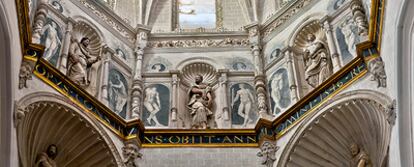The racy roof of Tarazona Cathedral
Nude figures on the dome of the building were too much for one bishop to bear
"I am not setting foot here again," said the bishop when he laid eyes on the nude figures. And, according to the chroniclers of the era, he didn't. These events took place in the mid-16th century, when Juan de Munébrega stepped into the cathedral of Tarazona, in Zaragoza province, and looked up at the dome, discovering the offending artwork by Alonso González. The prelate left, ordering that the bare skin be immediately covered up.
Three and a half centuries after the episcopal walkout, and after being shut down for repair work for nearly three decades, the cathedral of Santa María de la Huerta, in Tarazona, has reopened again. The locals are celebrating the recovery of a temple whose dome, cloister (still undergoing restoration) and tower are considered some of the best surviving examples of Mudéjar art.
Yet few will forget the years of anxiety that began in 1979, when the pillars of the transept began to show cracks. By 1984, the cracks were of such magnitude that the cathedral had to be closed down to reinforce its structure. As its name indicates, Santa María de la Huerta had been built on the town's agricultural land, outside the city walls, a well-irrigated spot that was better suited to growing vegetables than to erecting cathedrals.
The root of these structural problems was an oversight. At one point, the Mudéjar cloister was cemented into rock, which entailed channeling several springs through a canal that was eventually forgotten and abandoned. Over the years, seepage damaged the building.
The controversial artwork has its origins in a 1546 commission for the newly completed dome of the temple. Alonso González, who had just arrived from Italy, designed a fully classicist decoration that included scallop shells, evangelists, painted alabaster, plaster sculptures of eight disciples and paintings using the grisaille technique (shades of grey imitating the reliefs of sculptures).
It was the latter that the bishop had covered up, and they are a unique case in Europe of a cathedral decoration inspired on neo-Platonism. The characters depicted included some from the Bible, but also from the classical world, such as Apollo, Venus, Bacchus or Hercules. He also painted famous couples, like Caesar and Cleopatra, Helen and Paris, and Ulysses and Penelope.
Not far from here lies the episcopal palace, where visitors will be surprised to learn that Munébrega himself asked Alonso González to decorate the central staircase. The artist portrayed the bishop standing next to the emperor and his son Felipe, amid feminine sculptures representing the loves of Jupiter. These females certainly did not prevent the prelate from setting foot in the palace again.

Tu suscripción se está usando en otro dispositivo
¿Quieres añadir otro usuario a tu suscripción?
Si continúas leyendo en este dispositivo, no se podrá leer en el otro.
FlechaTu suscripción se está usando en otro dispositivo y solo puedes acceder a EL PAÍS desde un dispositivo a la vez.
Si quieres compartir tu cuenta, cambia tu suscripción a la modalidad Premium, así podrás añadir otro usuario. Cada uno accederá con su propia cuenta de email, lo que os permitirá personalizar vuestra experiencia en EL PAÍS.
¿Tienes una suscripción de empresa? Accede aquí para contratar más cuentas.
En el caso de no saber quién está usando tu cuenta, te recomendamos cambiar tu contraseña aquí.
Si decides continuar compartiendo tu cuenta, este mensaje se mostrará en tu dispositivo y en el de la otra persona que está usando tu cuenta de forma indefinida, afectando a tu experiencia de lectura. Puedes consultar aquí los términos y condiciones de la suscripción digital.
Últimas noticias
The complicated life of Francesca Albanese: A rising figure in Italy but barred from every bank by Trump’s sanctions
How Japan is trying to avert ‘digital defeat’
Half of Scotland is in the hands of 420 property owners
Reinhard Genzel, Nobel laureate in physics: ‘One-minute videos will never give you the truth’
Most viewed
- Pablo Escobar’s hippos: A serious environmental problem, 40 years on
- Why we lost the habit of sleeping in two segments and how that changed our sense of time
- Charles Dubouloz, mountaineering star, retires at 36 with a farewell tour inspired by Walter Bonatti
- Reinhard Genzel, Nobel laureate in physics: ‘One-minute videos will never give you the truth’
- The Florida Keys tourist paradise is besieged by immigration agents: ‘We’ve never seen anything like this’








































